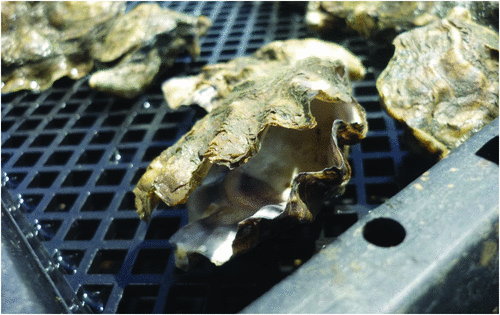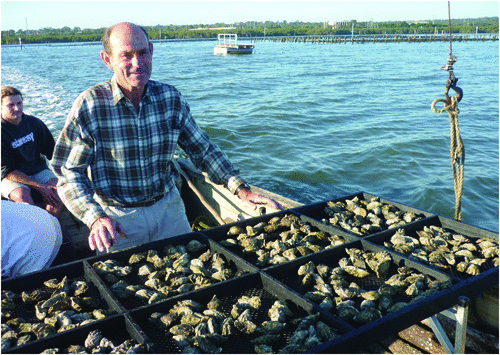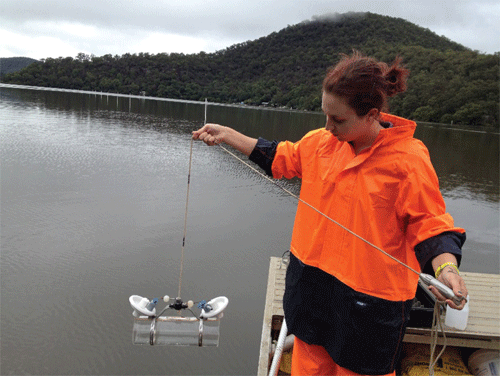Pacific oyster mortality syndrome: a marine herpesvirus active in Australia
Richard Whittington A D , Paul Hick A , Olivia Evans A , Ana Rubio A B , Navneet Dhand A and Ika Paul-Pont A CA Faculty of Veterinary Science, School of Life and Environmental Sciences, The University of Sydney, Camden, NSW 2570, Australia
B Hornsby Shire Council, Hornsby, NSW 1630, Australia
C CNRS, IUEM Technopôle Brest-Iroise, Rue Dumont d’Urville, 29280 Plouzané, France
D Corresponding author. Tel: +61 2 9351 1619, Email: richard.whittington@sydney.edu.au
Microbiology Australia 37(3) 126-128 https://doi.org/10.1071/MA16043
Published: 10 August 2016
Genotypes of Ostreid herpesvirus 1 (OsHV-1) known as microvariants cause the disease Pacific oyster mortality syndrome (POMS). Since its appearance in NSW in 2010, OsHV-1 microvariant has prevented the farming of Pacific oysters (Crassostrea gigas) in the affected estuaries near Sydney, following the initial massive outbreaks1,2. The arrival of the disease in southeast Tasmania in January 2016 has put the entire $53M industry in Australia in jeopardy3. The virus is a member of the Family Malacoherpesviridae4, which includes several invertebrate herpesviruses. The OsHV-1 genome consists of 207 439 base pairs, with organisation similar to that of mammalian herpesviruses. However, OsHV-1 contains two invertible unique regions (UL, 167.8 kbp; US, 3.4 kbp) each flanked by inverted repeats (TRL/IRL, 7.6 kbp; TRS/IRS, 9.8 kbp), with an additional unique sequence (X, 1.5 kbp) between IRL and IRS4. Unlike many herpesviruses which are host specific, OsHV-1 strains have been transmitted between marine bivalve species5 and the virus is transmitted indirectly. The virus may have relatively prolonged survival in the environment, has extremely high infection and case fatality rates, and latency is unproven. Along with pilchard herpesvirus6–8 and abalone ganglioneuritis virus9,10, it is part of a dawning reality that marine herpesviruses are among the most virulent of pathogens. Finding solutions for industry requires more than laboratory-based research.
In 2008, the microvariant genotype OsHV-1 µVar11 emerged as a dominant isolate against a background of prior endemic OsHV-1 strains in France, and has devastated the C. gigas industry there. Similar microvariant genotypes of OsHV-1 have since appeared throughout Europe, in New Zealand, and in Australia1, with similar devastating impact (Figure 1). In 2010–11 when an emergency response was required in Australia, almost no information existed on the epidemiology of OsHV-1 infection, and the only management responses internationally that could be drawn from were to develop resistant oysters through selective breeding approaches. In Australia, a breeding program commenced immediately but it was complemented by research to identify mechanisms of viral transmission and environmental triggers, in order to develop husbandry recommendations to mitigate losses.

|
Oysters are often grown in the intertidal zone. Replicated experiments were conducted in the Georges River estuary near Sydney in summer 2011–12 and 2012–13, to determine whether immersion time in seawater influenced viral exposure and mortality in different age classes of oyster (Figure 2). The findings were remarkably consistent. Reduction in immersion time by about 2 hours per tide cycle led to 50% reduction in mortality in valuable adult oysters12,13. Furthermore, assumptions about uniform seawater exposure to virus were shattered by observations of highly clustered infection and mortality patterns at scales of 1 km to a few cm. This was consistent with distribution patterns of estuarine plankton14. Accurate counts of thousands of live and dead research oysters placed in multiple locations in successive summers led to a hypothesis: that OsHV-1 may be carried in plankton15.

|
Most of the Pacific oysters grown in Australia are produced in Tasmania in large commercial hatcheries, certified free from diseases, and then shipped to farmers in New South Wales, South Australia and Tasmania to be grown and marketed. For this reason the occurrence of OsHV-1 in Tasmania was predicted to be a massive risk to the entire industry. Based on the idea that OsHV-1 was probably carried on organic or inorganic particles with the plankton, experiments were conducted to prevent mortality by filtering seawater or aging it by sedimentation to remove the causative agent. Filtration would not have been an obvious solution for a viral aetiology were it not for the epidemiological observations, and evidence that testing a pellet derived from low speed centrifugation of seawater improved detection of the virus16 (Figure 3). Controlled experiments on these water treatments were successful17 and the results were taken up by the hatcheries. In January 2016, when POMS emerged in Tasmania, one hatchery had appropriate water treatment in place and did not experience mortality in its stock while a second had not completed its water treatment program and was severely affected by the disease.

|
The state jurisdictions implemented quarantine controls over affected estuaries in both NSW and TAS and this has been very effective in slowing the spread of the disease. This has been accompanied by research to confirm appropriate disinfection protocols. Surprisingly, OsHV-1 remained viable for at least a week within dried oyster tissues, such as those that might adhere to plastic farm trays and baskets in which oysters are grown. Disinfection of such material with high concentrations of chlorine was ineffective. However, quarternary ammonium compounds were effective18. Biosecurity controls apply only to oysters and oyster farming equipment, leaving many potential pathways for spread of the virus. Pleasure boats, commercial shipping, and oceanic currents may all play a role in international and regional spread of aquatic pathogens.
Pathogen distribution and disease expression may be favoured by environmental conditions. POMS occurs in Sydney estuaries when water temperature is ~22−26°C1,2; this is ~5oC higher than in France19,20. An experimental infection model has been developed and used in Australia to confirm these field observations on water temperature; it revealed an important interaction between water temperature and infectious dose21,22. As part of FRDC funded research we have established water temperature monitoring on oyster leases in all major C. gigas farming areas in Australia to provide insight into a very dynamic thermal environment. The aim is to develop a risk management and early warning system.
Over time a combination of biosecurity, husbandry and genetic approaches will need to be applied to continue farming Pacific oysters in Australia.
Acknowledgements
Our research is funded by Fisheries Research and Development Corporation. Further information is available at www.oysterhealthsydney.org.
References
[1] Jenkins, C. et al. (2013) Identification and characterisation of an ostreid herpesvirus-1 microvariant (OsHV-1 micro-var) in Crassostrea gigas (Pacific oysters) in Australia. Dis. Aquat. Organ. 105, 109–126.| Identification and characterisation of an ostreid herpesvirus-1 microvariant (OsHV-1 micro-var) in Crassostrea gigas (Pacific oysters) in Australia.Crossref | GoogleScholarGoogle Scholar | 1:CAS:528:DC%2BC3sXhsFynsbvL&md5=70296bbb94ee5b1c073ed317d9e7f76cCAS | 23872855PubMed |
[2] Paul-Pont, I. et al. (2014) Descriptive epidemiology of mass mortality due to Ostreid herpesvirus-1 (OsHV-1) in commercially farmed Pacific oysters (Crassostrea gigas) in the Hawkesbury River estuary Aust. Aquacult. 422–423, 146–159.
| Descriptive epidemiology of mass mortality due to Ostreid herpesvirus-1 (OsHV-1) in commercially farmed Pacific oysters (Crassostrea gigas) in the Hawkesbury River estuaryCrossref | GoogleScholarGoogle Scholar |
[3] Horvat, P. (2011) New threat to Pacific oysters. December. In FISH, pp. 14–15, Fisheries Research and Development Corporation.
[4] Davison, A.J. et al. (2005) A novel class of herpesvirus with bivalve hosts. J. Gen. Virol. 86, 41–53.
| A novel class of herpesvirus with bivalve hosts.Crossref | GoogleScholarGoogle Scholar | 1:CAS:528:DC%2BD2MXlt1Khsg%3D%3D&md5=8a9e447e01091f98863447c2ae14a479CAS | 15604430PubMed |
[5] Arzul, I. et al. (2001) Evidence for interspecies transmission of oyster herpesvirus in marine bivalves. J. Gen. Virol. 82, 865–870.
| Evidence for interspecies transmission of oyster herpesvirus in marine bivalves.Crossref | GoogleScholarGoogle Scholar | 1:CAS:528:DC%2BD3MXisFWms7g%3D&md5=dd04616e79db2fd2d86983327af65963CAS | 11257192PubMed |
[6] Hyatt, A.D. et al. (1997) Epizootic mortality in the pilchard Sardinops sagax neopilchardus in Australia and New Zealand in 1995. 2. Identification of a herpesvirus within the gill epithelium. Dis. Aquat. Organ. 28, 17–29.
| Epizootic mortality in the pilchard Sardinops sagax neopilchardus in Australia and New Zealand in 1995. 2. Identification of a herpesvirus within the gill epithelium.Crossref | GoogleScholarGoogle Scholar |
[7] Whittington, R.J. et al. (2008) Herpesvirus that caused epizootic mortality in 1995 and 1998 in pilchard, Sardinops sagax neopilchardus (Steindachner), in Australia is now endemic. J. Fish Dis. 31, 97–105.
| Herpesvirus that caused epizootic mortality in 1995 and 1998 in pilchard, Sardinops sagax neopilchardus (Steindachner), in Australia is now endemic.Crossref | GoogleScholarGoogle Scholar | 1:STN:280:DC%2BD1c%2FnslCisA%3D%3D&md5=dff887535802876234cd601375179f0cCAS | 18234017PubMed |
[8] Whittington, R.J. et al. (1997) Epizootic mortality in the pilchard Sardinops sagax neopilchardus in Australia and New Zealand in 1995. 1. Pathology and epizootiology. Dis. Aquat. Organ. 28, 1–15.
| Epizootic mortality in the pilchard Sardinops sagax neopilchardus in Australia and New Zealand in 1995. 1. Pathology and epizootiology.Crossref | GoogleScholarGoogle Scholar |
[9] Hooper, C. et al. (2007) Ganglioneuritis causing high mortalities in farmed Australian abalone (Haliotis laevigata and Haliotis rubra). Aust. Vet. J. 85, 188–193.
| Ganglioneuritis causing high mortalities in farmed Australian abalone (Haliotis laevigata and Haliotis rubra).Crossref | GoogleScholarGoogle Scholar | 1:STN:280:DC%2BD2s3mtFShtA%3D%3D&md5=b3e21e6400fb50f9536183d148a78538CAS | 17470067PubMed |
[10] Savin, K. et al. (2010) A neurotropic herpesvirus infecting the gastropod, abalone, shares ancestry with oyster herpesvirus and a herpesvirus associated with the amphioxus genome. Virol. J. 7, 308.
| A neurotropic herpesvirus infecting the gastropod, abalone, shares ancestry with oyster herpesvirus and a herpesvirus associated with the amphioxus genome.Crossref | GoogleScholarGoogle Scholar | 21062506PubMed |
[11] Segarra, A. et al. (2010) Detection and description of a particular Ostreid herpesvirus 1 genotype associated with massive mortality outbreaks of Pacific oysters, Crassostrea gigas, in France in 2008. Virus Res. 153, 92–99.
| Detection and description of a particular Ostreid herpesvirus 1 genotype associated with massive mortality outbreaks of Pacific oysters, Crassostrea gigas, in France in 2008.Crossref | GoogleScholarGoogle Scholar | 1:CAS:528:DC%2BC3cXhtFamsrrM&md5=d043b0babb72a2df482aac1021376e1aCAS | 20638433PubMed |
[12] Whittington, R. et al. (2015) Further observations on the influence of husbandry practices on OsHV-1 μVar mortality in Pacific oysters Crassostrea gigas: age, cultivation structures and growing height. Aquaculture 438, 82–97.
| Further observations on the influence of husbandry practices on OsHV-1 μVar mortality in Pacific oysters Crassostrea gigas: age, cultivation structures and growing height.Crossref | GoogleScholarGoogle Scholar |
[13] Paul-Pont, I. et al. (2013) Influence of husbandry practices on OsHV-1 associated mortality of Pacific oysters Crassostrea gigas. Aquaculture 412–413, 202–214.
| Influence of husbandry practices on OsHV-1 associated mortality of Pacific oysters Crassostrea gigas.Crossref | GoogleScholarGoogle Scholar |
[14] Suthers, I.M. and Rissik, D. (2009) Plankton – A Guide to Their Ecology and Monitoring for Water Quality, CSIRO Publishing.
[15] Paul-Pont, I. et al. (2013) Spatial distribution of mortality in Pacific oysters Crassostrea gigas: reflection on mechanisms of OsHV-1 transmission. Dis. Aquat. Organ. 105, 127–138.
| Spatial distribution of mortality in Pacific oysters Crassostrea gigas: reflection on mechanisms of OsHV-1 transmission.Crossref | GoogleScholarGoogle Scholar | 23872856PubMed |
[16] Evans, O. et al. (2014) A simple centrifugation method for improving the detection of Ostreid herpesvirus-1 (OsHV-1) in natural seawater samples with an assessment of the potential for particulate attachment. J. Virol. Methods 210, 59–66.
| A simple centrifugation method for improving the detection of Ostreid herpesvirus-1 (OsHV-1) in natural seawater samples with an assessment of the potential for particulate attachment.Crossref | GoogleScholarGoogle Scholar | 1:CAS:528:DC%2BC2cXhslags7rF&md5=afdad2a5ea98172dc7de1f7cf35f5fd5CAS | 25286178PubMed |
[17] Whittington, R. et al. (2015) Protection of Pacific oyster (Crassostrea gigas) spat from mortality due to Ostreid herpesvirus-1 OsHV-1 µVar) using simple treatments of incoming seawater in land-based upwellers. Aquaculture 437, 10–20.
| Protection of Pacific oyster (Crassostrea gigas) spat from mortality due to Ostreid herpesvirus-1 OsHV-1 µVar) using simple treatments of incoming seawater in land-based upwellers.Crossref | GoogleScholarGoogle Scholar |
[18] Hick, P. et al. (2016) Stability of Ostreid herpesvirus-1 (OsHV-1) and assessment of disinfection of seawater and oyster tissues using a bioassay. Aquaculture 450, 412–421.
| Stability of Ostreid herpesvirus-1 (OsHV-1) and assessment of disinfection of seawater and oyster tissues using a bioassay.Crossref | GoogleScholarGoogle Scholar | 1:CAS:528:DC%2BC2MXhsVyrsL7M&md5=fce755dfdbf2257370d29ef05694625eCAS |
[19] Petton, B. et al. (2013) Temperature influence on pathogen transmission and subsequent mortalities in juvenile Pacific oysters Crassostrea gigas. Aquacult. Environ. Interact. 3, 257–273.
| Temperature influence on pathogen transmission and subsequent mortalities in juvenile Pacific oysters Crassostrea gigas.Crossref | GoogleScholarGoogle Scholar |
[20] Renault, T. et al. (2014) Ostreid herpesvirus 1 infection among Pacific oyster (Crassostrea gigas) spat: relevance of water temperature to virus replication and circulation prior to the onset of mortality. Appl. Environ. Microbiol. 80, 5419–5426.
| Ostreid herpesvirus 1 infection among Pacific oyster (Crassostrea gigas) spat: relevance of water temperature to virus replication and circulation prior to the onset of mortality.Crossref | GoogleScholarGoogle Scholar | 24973071PubMed |
[21] Paul-Pont, I. et al. (2015) Experimental infections of Pacific oyster Crassostrea gigas using the Australian ostreid herpesvirus-1 (OsHV-1) μVar strain. Dis. Aquat. Organ. 113, 137–147.
| 25751856PubMed |
[22] de Kantzow, M. et al. (2016) Effect of water temperature on mortality of Pacific oysters Crassostrea gigas associated with microvariant ostreid herpesvirus 1 (OsHV-1 μVar). Aquacult. Environ. Interact. 8, 419–428.
Biographies
Richard Whittington, PhD, FASM, is Professor of Farm Animal Health. Paul Hick, PhD, is Senior Lecturer in Veterinary Virology. Olivia Evans, BAnVetBioSc, is a final year PhD student. Ana Rubio, PhD, is a marine scientist. Navneet Dhand, PhD, is Associate Professor in Biostatistics and Epidemiology. Ika Paul-Pont, PhD, is Research Fellow in Environmental Immunology. Their studies combine the disciplines of virology, epidemiology, pathobiology and marine science to discover weaknesses in disease biology that can be exploited for disease control and prevention in aquaculture and fisheries.


